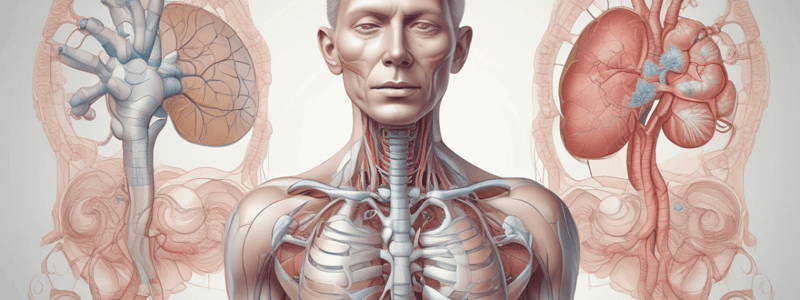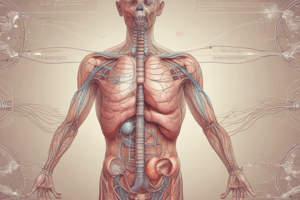Podcast
Questions and Answers
What is the primary function of the respiratory system?
What is the primary function of the respiratory system?
- To digest food
- To circulate blood throughout the body
- To regulate body temperature
- To move oxygen into the body and carbon dioxide out (correct)
What is the purpose of the mucus and hairs in the nose?
What is the purpose of the mucus and hairs in the nose?
- To aid in the digestion of food
- To warm the air entering the body
- To trap bacteria and other unwanted substances (correct)
- To produce sound when speaking
What is the passageway for both food and air?
What is the passageway for both food and air?
- Nose
- Mouth
- Throat (correct)
- Larynx
Why do the blood vessels in the nose help to warm the air?
Why do the blood vessels in the nose help to warm the air?
What is the purpose of the nostrils?
What is the purpose of the nostrils?
What is the function of the epiglottis in the respiratory system?
What is the function of the epiglottis in the respiratory system?
What happens when air moves through the respiratory tract?
What happens when air moves through the respiratory tract?
What is the trachea's primary function?
What is the trachea's primary function?
What is the reflex that helps remove objects from the trachea?
What is the reflex that helps remove objects from the trachea?
Where are the lungs located in the body?
Where are the lungs located in the body?
Study Notes
Respiratory System
- The respiratory system is responsible for breathing, moving oxygen into the body and carbon dioxide out of the body.
- The system is divided into two parts: the upper and lower respiratory tracts.
Upper Respiratory Tract
- The upper respiratory tract includes the nose, throat, larynx, and trachea.
- The nose channels air into the body, regardless of its shape or size.
- The mouth can also channel air, but has other responsibilities like eating and smiling.
- The nose and mouth are the only visible parts of the respiratory system.
Nose
- Air enters the body through nostrils, the openings at the bottom of the nose.
- The mucus-covered inner walls of the nose have tiny blood vessels and hairs that:
- Warm the air entering the body through warm blood flow.
- Trap bacteria and other unwanted particles through sticky mucus lining and hairs.
- These blood vessels can bleed when you have a nosebleed.
Throat (Pharynx)
- The throat receives air from the nose and mouth and directs it to the lungs.
- The epiglottis, a flap of tissue, covers the path to the lungs when you swallow, ensuring food goes to the stomach and air goes to the lungs.
Larynx (Voice Box)
- The larynx is located inside the throat and enables sound production through vocal cords.
- The epiglottis acts as a lid that covers the larynx when you swallow.
Trachea (Windpipe)
- The trachea is a firm tube in the upper chest that carries air from the larynx to the lungs.
- Coughing is a reflex that forces air out of the lungs to push objects out of the trachea, keeping the airway open.
Studying That Suits You
Use AI to generate personalized quizzes and flashcards to suit your learning preferences.
Description
Explore the importance of breathing and the role of the respiratory system in bringing oxygen into our bodies and removing carbon dioxide. Learn how it works and its significance for our survival.


